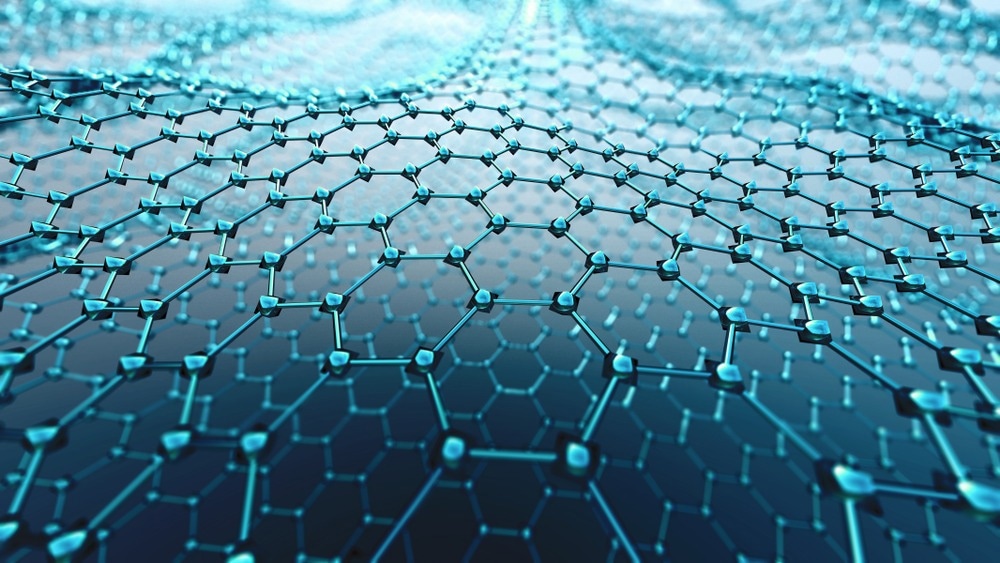Quantum Hall (QH) effect allows the exploitation of quantum coherence of electrons for various applications from metrology to quantum computation. QH interferometry is a convenient tool that provides an archetypal platform to achieve fractional QH state braiding statistics. However, a phase coherence along the length of the interferometer and suppression of Coulomb charging energy is required to observe fractional statistics.

Study: Quantum Hall interferometry in triangular domains of marginally twisted bilayer graphene. Image Credit: Neon_dust/Shutterstock.com
In an article recently published in the journal Nano Letters, a QH interferometer was fabricated based on marginally twisted bilayer graphene with a twist angle (θ) of 0.16 degrees. The device operations in the QH regime resulted in magneto-thermopower’s unique features, including Aharonov–Bohm (AhB) and Fabry–Pérot (FP) oscillations in the density–magnetic field phase, wherein filling factors of Landau level (ν) were 4, 8.
The QH interference effects were restricted to the triangular domains of AB/BA in marginally twisted bilayer graphene and showed lower Coulomb charging effects. The overall results demonstrated the QH edge mode’s phase-coherent interference without the need for an additional complex architecture, defined by a logic gate in twisted bilayer graphene material.
QH Interferometry in Triangular Domains and Twisted Bilayer Graphene
The hierarchy of the quasiparticle excitations can be investigated using the interference between fractional QH and integer edge modes. This method can help observe the quasiparticle’s non-Abelian braiding statistics in the fractional QH regime. However, it is challenging to experimentally achieve this phenomenon due to unavoidable Coulomb repulsion from the quasiparticles, which are spatially confined, consequently changing the interferometer’s effective area.
The interferometer’s additional charging effect impedes the robustness of braiding statistics. However, increasing the device dimensions can prevent the impact of an additional charge on the interferometer at the cost of phase coherence allying the interfering paths. As a result, various device architectures were designed, and materials were engineered to suppress the Coulomb repulsion without affecting the quasiparticle’s phase coherence.
The physical properties of twisted bilayer graphene depend on the twist angle between the two layers of these two-dimensional (2D) materials. The twisted bilayer graphene has a twist angle close to 1.1 degrees. This twisted bilayer graphene 2D material shows phase transitions from a conducting system to a correlated insulator phase, a ferromagnetic phase, and a superconductivity phase.
The present study discussed a new QH interferometer operation based on the marginally twisted bilayer graphene. The band structure of the moiré lattice of twisted bilayer graphene around the magic angle (θm) of 1.1 degrees can facilitate a wide range of novel phases like superconductivity, magnetism, and correlated insulators.
However, at the twisted angle of twisted bilayer graphene below θm, the atomic registries in the moiré lattice are altered due to the relaxation effects, leading to the mosaic structure of triangular regions with alternating AB and BA stacking, separated by domain walls. However, the gapping out of AB or BA regions in twisted bilayer graphene due to the vertical displacement field results in a one-dimensional (1D) network conducting channels hosted by the domain walls.
Triangular Domains of Marginally Twisted Bilayer Graphene
Here, the thermoelectric and electric measurements were performed in marginally twisted bilayer graphene with θ of 1.6 degrees in the integer QH regime and at negligible displacement fields. Here, the thermoelectric coefficient provided the electronic state’s fundamental characterization due to the charge carrier’s sensitivity towards scattering dynamics.
Additionally, the quasiparticle excitations carried the entropy in the QH regime. In this regime, the magneto-thermopower provided an insight into the quasiparticle spectrum. Moreover, under suitable conditions, the thermoelectric measurements helped explore the non-Abelian quasiparticle’s statistical properties due to the higher entropy of anyons than Abelian. In the QH regime, various characteristics of the interference effect were investigated using the correlation between thermal voltage and magnetic field (B) along with gate-induced density (n).
Conclusion
In summary, the magneto-thermopower transport of marginally twisted bilayer graphene was measured using θ of approximately 0.16 degrees. The thermovoltage’s periodic oscillations in B and n were in concurrence with electronic FP and AhB interference between the trajectories of charge carriers which enclosed limited magnetic flux at a lower temperature of 3 kelvin in twisted bilayer graphene.
The thermovoltage measurements showed periodic oscillations, which were absent in conventional resistance measurements. The resonance pattern emerged in the QH regime at ν of 4 and 8. The loop obtained from the periodicity of AhB-oscillations was like moiré lattice size.
The overall results indicated that the local Landau level’s charge carriers are within the AB/BA triangular domains. Additionally, the QH modes interfered through AA-stacked regions. The native QH interference effect in marginally twisted bilayer graphene could serve as a novel platform to achieve anyonic statistics in the QH regime.
Reference
Mahapatra, P. S., Garg, M., Ghawri, B., Jayaraman, A., Watanabe, K., Taniguchi, T., Ghosh, A et al. (2022). Quantum Hall interferometry in triangular domains of marginally twisted bilayer graphene. Nano Letters. https://pubs.acs.org/doi/10.1021/acs.nanolett.2c00627
Disclaimer: The views expressed here are those of the author expressed in their private capacity and do not necessarily represent the views of AZoM.com Limited T/A AZoNetwork the owner and operator of this website. This disclaimer forms part of the Terms and conditions of use of this website.